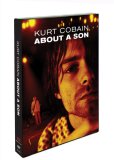| Reviews & Columns |
|
Reviews DVD TV on DVD Blu-ray 4K UHD International DVDs In Theaters Reviews by Studio Video Games Features Collector Series DVDs Easter Egg Database Interviews DVD Talk Radio Feature Articles Columns Anime Talk DVD Savant Horror DVDs The M.O.D. Squad Art House HD Talk Silent DVD
|
DVD Talk Forum |
|
|
| Resources |
|
DVD Price Search Customer Service #'s RCE Info Links |
|
Columns
|
|
|
Kurt Cobain - About a Son
Kurt Cobain About a Son is thoroughly unconventional. It includes no Nirvana songs, no interviews with bandmates, friends, or family; in fact, no talking heads of any kind, not even Cobain's. Instead Schnack has married an hour and a half of excerpts from the Cobain-Azerrad interviews to newly-shot 35mm footage of Washington State locales and locals, then added a handful of Charles Peterson's iconic photos of Cobain, a contemplative score by Steve Fisk, and several songs more or less influential to Cobain from the likes of Queen, Creedence Clearwater Revival, Bad Brains, The Vasalines, David Bowie, and Butthole Surfers.
Little of what Cobain has to say here will be news to fans of the celebrity behind Nirvana's music. He credits his aunt Mary for turning him on to music. Cobain blames his dad for ruining his childhood by divorcing his mom. He admits to purposefully cultivating a sense of alienation. He makes claims of back and stomach pains, social anxiety, and manic depression more-or-less attributable to his unhappy post-divorce childhood. He cops to self-medicating with pot, opiates, and heroin; to enjoying the fruits of success, but intensely hating the media attention. He speaks of wanting to always be in his daughter's life and wanting to fix his relationship with his wife, but he also often speaks of suicide. Though this is all pretty well documented elsewhere, including in Azerrad's 1993 book Come as You Are: The Story of Nirvana, dedicated fans may appreciate finally hearing it directly from Cobain.
The visuals are complementary to the audio, but freewheeling. Cobain's words play mostly over contemporary footage of the three Washington State locales that he spent most of his life in: the logging town of Aberdeen, bohemian Olympia, and the metropolis of Seattle. We're shown places familiar to Cobain such as his residences and high school, a lumber mill where his father worked, and local coffee shops and music venues he hung out or played in, but Schnack and cinematographer Wyatt Toll also present places that Cobain wouldn't have recognized like Seattle's Central Library which was constructed after his death, and they spend a lot of time constructing beautiful portraitures-on-film of ordinary people. Given that Cobain was a recluse who rarely mixed with ordinary people when he could help it, these portraits, like the Central Library footage, may say more about what interests Schnack than they do about Cobain, but they're nevertheless engaging.
The DVD
The Video:
Kurt Cobain About a Son looks great. The original 1.78:1 theatrical image is retained and the 35mm footage is given an anamorphic presentation. Colors are robust and video noise is absent. Slight variations in film stock used between the three principal shooting locations are a subtle touch which is preserved well by this fine disc.
Subtitles are not offered.
The Audio:
The disc provides 2.0 and 5.1 audio options. Both mixes sound excellent, especially given the nature of the source Cobain recordings.
The Extras:
The disc includes three short featurettes: The Voices Behind About a Son (13 min.), in which Azerrad and Schnack discuss the origin of the recordings and the process of creating the documentary; Selected Scene Commentary by Director AJ Schnack (17 min.), providing detail on what the images show and how they were selected; and, On Location: Scouting Video to Scene Comparison (8 min.) which provides a side-by-side comparison between early scouting video and final shots used in the film.
Final Thoughts:
The loose connection between Cobain's words and Toll's cinematography begs the question whether these projects wouldn't have been stronger independently. Surely there are some Nirvana fans that would have preferred to have the audio recordings unadulterated. Undoubtedly, the intimacy of hearing Cobain's words flowing directly into one's ears via headphone unmediated by Toll's images would have provided an experience quite different from this one. Additionally, it is not hard to image Toll's images with just Fisk's score. Nevertheless, the whole works well even if it may be no better than the sum of its parts.
|
| Popular Reviews |
| Sponsored Links |
|
|
| Sponsored Links |
|
|
| Release List | Reviews | Shop | Newsletter | Forum | DVD Giveaways | Blu-Ray | Advertise |
|
Copyright 2024 DVDTalk.com All Rights Reserved. Legal Info, Privacy Policy, Terms of Use,
Manage Preferences,
Your Privacy Choices | |||||||















